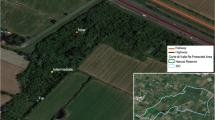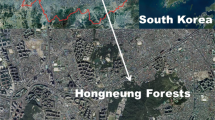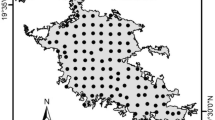Summary
Traffic noise is known to have a negative impact on bird populations in general, but little is known about the mechanisms by which sound pollution affects bird communities. However, a knowledge of these mechanisms is imperative if we want to account for the differences in susceptibility to traffic noise that exist between species, and may thus be critical for conservation action. To address this issue, population assessments were carried out in a contiguous area of oak-beech forest at differing distances from a much frequented motorway to determine the road effect on the whole bird community. As expected, species richness and diversity decreased towards the motorway, and bird abundance was significantly lower along the motorway than in the control area. However, a few species defied the negative impact of the motorway. The songs of the more abundant passerines were analysed with regard to three frequency parameters to determine whether or not a relationship exists between the song pitch of a species and its sensitivity to noise pollution. A significant relationship was found between dominant frequency and decline in abundance towards the motorway, which indicates that having a higher-pitched song with frequencies well above those of traffic noise makes a bird less susceptible to noise pollution. These results suggest that acoustic masking is one of the mechanisms by which traffic noise negatively affects passerine density along roads.
Zusammenfassung
Verkehrslärm hat negative Auswirkungen auf Vogelbestände. Sehr wenig ist jedoch bekannt über die Mechanismen, durch welche Lärm zur Beeinträchtigung von Vogelgemeinschaften beiträgt. Dabei ist die Kenntnis eben dieser Mechanismen unerlässlich, wenn man Vorhersagen treffen will bezüglich der Unterschiede in Lärmempfindlichkeit, die es zwischen verschiedenen Arten gibt, beispielsweise im Rahmen von Schutzprogrammen. Um dieser Frage nachzugehen, wurden Bestandserfassungen in einem zusammenhängenden Eichen-Buchenwaldgebiet in unterschiedlichen Abständen zu einer viel befahrenen Autobahn durchgeführt. So konnten die Auswirkungen der Straße auf die gesamte Vogelgemeinschaft erfasst werden. Erwartungsgemäß nahmen Artenreichtum und Diversität zur Autobahn hin ab. Ebenso waren Vogelabundanzen entlang der Autobahn signifikant tiefer als im Kontrollgebiet. Dennoch zeigten sich einige Arten nicht beeinträchtigt durch die Autobahn. Um festzustellen, ob zwischen Gesangsfrequenz und Lärmempfindlichkeit ein Zusammenhang besteht, wurden die Gesänge der häufigeren Singvogelarten in Bezug auf drei Frequenzparameter untersucht. Die dominante Frequenz eines Gesanges korrelierte dabei signifikant mit der Bestandsabnahme zur Autobahn hin, was andeutet, dass Vögel mit Gesangsfrequenzen, die weit über den Frequenzen von Verkehrsgeräuschen liegen, weniger lärmempfindlich sind. Diesen Ergebnissen zufolge ist die akustische Überdeckung von Vogelgesang in den Frequenzbereichen von Straßenlärm einer der Mechanismen, durch welche Singvogeldichten entlang von Straßen negativ beeinträchtigt werden.
Similar content being viewed by others
References
Begon, M., Harper, J. L. & Townsend, C. R. (1996): Ecology (Third edition). Oxford.
Bergen, F. & Abs, M. (1997): Etho-ecological study of the singing activity of the Blue Tit (Parus caeruleus), Great Tit (Parus major) and Chaffinch (Fringilla coelebs). J. Ornithol. 138: 451–467.
Bergmann, H. H. (1993): Der Buchfink: Neues über einen bekannten Sänger. Wiesbaden.
Bibby, C.J., Burgess, N.D. & Hill, D.A. (1992): Methoden der Feldornithologie. Radebeul.
Brumm, H. & Todt, D. (2002): Noise-dependent song amplitude regulation in a territorial songbird. Anim. Behav. 63: 891–897.
Clark, W.D. & Karr, J.R. (1979): Effects of highways on Red-winged Blackbird and Horned Lark populations. Wilson Bulletin 91: 143–145.
Dunning, J. B. (1993): CRC Handbook of Avian Body Masses. Boca Raton.
Ellenberg, H., Muller, K. & Stottele, T. (1981): Straßen-Ökologie. In: Walper, K.H., Ellenberg, H., Muller, K. & Stottele, T. (Eds.): Ökologie und Straße: 19–115. Bonn, Broschurenreihe der Deutschen Straßenliga.
Forman, R. T. T. (2000): Estimate of the Area Affected Ecologically by the Road System in the United States. Conservation Biology 14: 31–35.
Forman, R.T.T. & Hersperger, A.M. (1996): Road ecology and road density in different landscapes, with international planning and mitigation solutions. In: Evink, G. L., Garrett, P., Zeigler, D. & Berry, J. (Eds.): Proceedings of the international conference on wildlife ecology and transportation: 1–22. Publication FL-ER-69-98. Florida Department of Transportation, Tallahassee.
Forman, R.T.T. & Alexander, L.E. (1998): Roads and their major ecological effects. Ann. Rev. Ecol. System. 29: 207–231.
Forman, R. T. T. & Deblinger, R. D. (1998): The ecological road-effect zone for transportation planning, and a Massachusetts highway example. In: Evink, G. L., Garrett, P., Zeigler, D. & Berry, J. (Eds.): Proceedings of the international conference on wildlife ecology and transportation: 78–96. Publication FL-ER-69-98. Florida Department of Transportation, Tallahassee.
Forman, R.T.T. & Deblinger, R.D. (1999): The ecological road-effect zone of a Massachusetts (USA) suburban highway. Conserv. Biol. 14: 36–46.
Forman, R.T.T., Friedman, D. S., Fitzhenry, D., Martin, J.D., Chen, A. S. & Alexander, L.E. (1997): Ecological effects of roads: towards three summary indices and an overview for North America. In: Canters, K. (Ed.): Habitat fragmentation and infrastructure: 40–45. Ministry of Transport, Public Works and Water Management, Delft, The Netherlands.
Fretwell, S.D. (1972): Populations in a Seasonal Environment. Princeton.
Glas, P. (1962): Factors governing density in the chaffinch (Fringilla coelebs) in different types of wood. Archives Néeerlandaises de Zoologie 13: 466–472.
Illner, H. (1992): Effects of roads with heavy traffic on grey partridgee (Perdix perdix) density. Gibier Faune Sauvage 9:467–480.
Joveniaux, A. (1985): Influence de la mise en service d'une autoroute sur la faune sauvage. In: Bernard, J.-M., Lansiart, M., Kempf, C. & Tille, M. (Eds.): Actes du colloque Routes et Faune Sauvage: 211–228. Colmar.
Junker-Bornholdt, R., Wagner, M., Zimmermann, M., Simonis, S., Schmidt, K. & Wiltschko, W. (1998): The impact of a motorway in construction and after opening to traffic on the breeding biology of Great Tit (Parus major) and Blue Tit (P. caeruleus). J. Ornithol. 139: 131–139.
Klump, G. M. (2001): Die Wirkung von Lärm auf die auditorische Wahrnehmung der Vögel. An-gew. Landschaftsökologie 44: 9–23.
Leedy, D.L. & Adams, L.W. (1982): Wildlife Considerations in Planning and Managing Highway Corridors. Report No. FWHA-TS-82-212, Office of Research, Federal Highway Administration, US Department of Administration, Washington.
O'Connor, R. J. & Fuller, R. J. (1985): Bird population responses to habitat. In: Taylor, K., Fuller, R. J. & Lack, P. C. (Eds.): Bird Census and Atlas Studies: Proceedings of the VII International Conference on Bird Census Work and Atlas Work: 197–211. Tring.
Räty, M. (1979): Effect of highway traffic on tetraonid densities. Orn. Fenn. 56: 255–260.
Reijnen, R. & Foppen, R. (1994): The effects of car traffic on breeding bird populations in woodland. I. Evidence of reduced habitat quality for willow warblers (Phylloscopus trochilus) breeding close to a highway. J. Appl. Ecol. 31: 85–94.
Reijnen, R. & Foppen, R. (1995): The effects of car traffic on breeding bird populations in woodland. IV. Influence of population size on the reduction of density close to a highway. J. Appl. Ecol. 32: 481–491.
Reijnen, R., Foppen, R., ter Braak, C. & Thissen, J. (1995): The effects of car traffic on breeding bird populations in woodland. III. Reduction of density in relation to the proximity of main roads. J. Appl. Ecol. 32: 187–202.
Reijnen, R., Foppen, R. & Meeuwsen, H. (1996): The effects of traffic on the density of breeding birds in Dutch agricultural grasslands. Biology and Conservation 75: 255–260.
Reijnen, R., Foppen, R. & Veenbaas, G. (1997): Disturbance by traffic of breeding birds: evaluation of the effect and considerations in planning and managing road corridors. Biodiversity and Conservation 6: 567–581.
Roche, J. C. (1990): Die Vogelstimmen Europas (cassette). Stuttgart.
Ryan, M.J. & Brenowitz, E. A. (1985): The role of body size, phylogeny and noise in the evolution of bird song. Amer. Nat. 126: 87–100.
Skiba, R. (2000): Possible “Rain Call” Selection in the Chaffinch (Fringilla coelebs) by noise intensity — an investigation of a hypothesis. J. Ornithol. 141: 160–167.
Thiollay, J. M. (1989): Censusing of diurnal raptors in a primary rainforest: Comparative methods and species detectability. J. Raptor Res. 23: 72–84.
Tokeshi, M. (1999): Species Coexistence. Oxford.
Van der Zande, A. N., ter Keurs, W. J. & van der Weijden, W.J. (1980): The impact of roads on the densities of four bird species in an open field habitat — evidence of a long-distance effect. Biology and Conservation 18: 299–321.
Van Home, B. (1983): Density as a misleading indicator of habitat quality. J. Wildlife Manag. 47: 893–901.
Wiley, R. H. (1991): Associations of song properties with habitats for territorial oscine birds of eastern North America. Amer. Nat. 138: 973–993.
Zahn, U. (1992): Diercke Weltatlas. Braunschweig.
Author information
Authors and Affiliations
Rights and permissions
About this article
Cite this article
Rheindt, F.E. The impact of roads on birds: Does song frequency play a role in determining susceptibility to noise pollution?. J Ornithol 144, 295–306 (2003). https://doi.org/10.1007/BF02465629
Accepted:
Published:
Issue Date:
DOI: https://doi.org/10.1007/BF02465629




